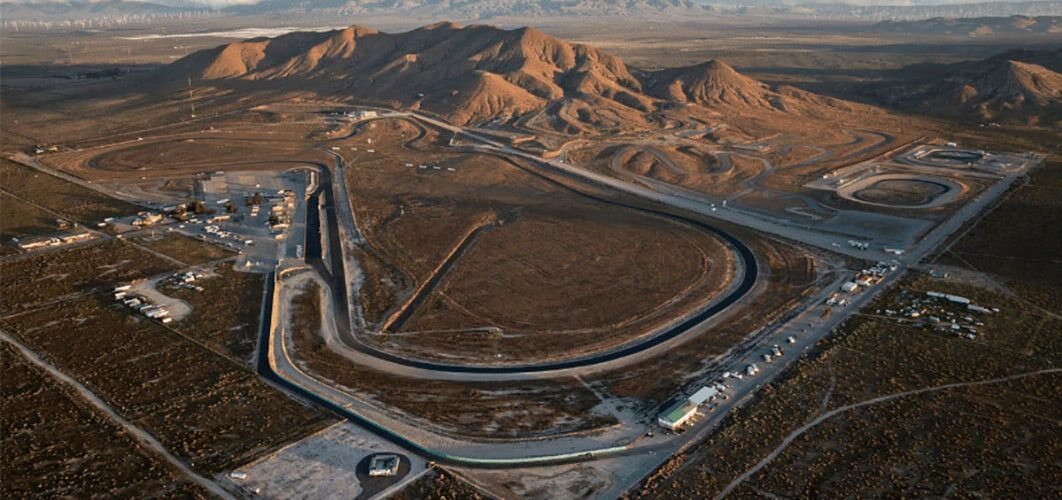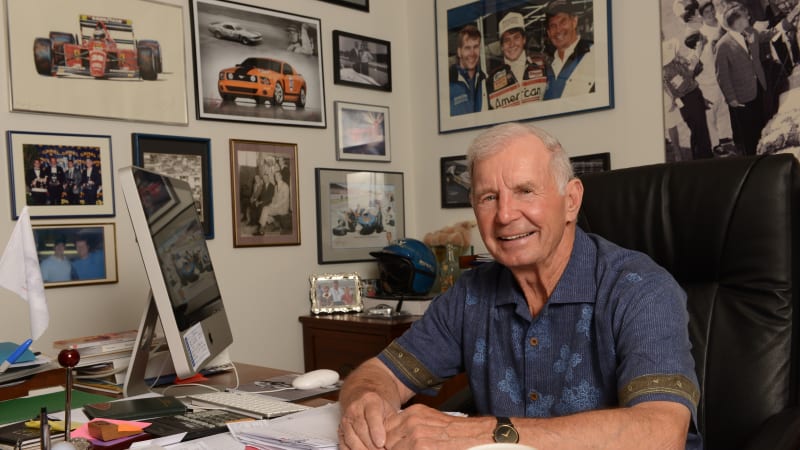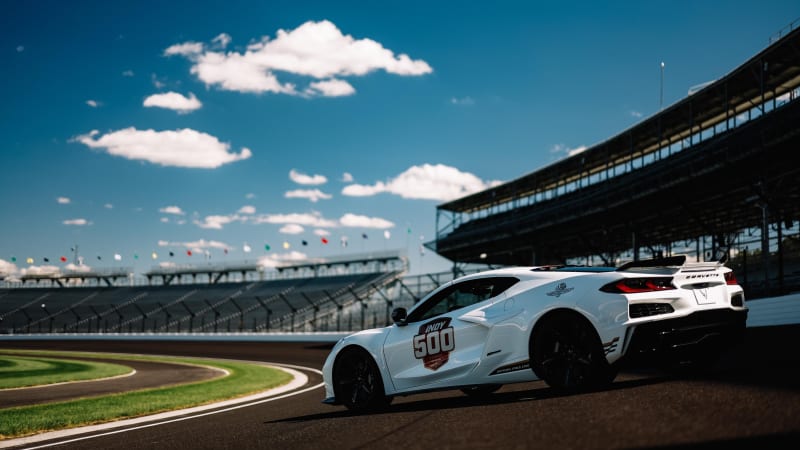This year’s Indy 500 pace car, the Chevrolet Corvette E-Ray. (Penske Entertainment: Joe Skibinski)
Before Rick Mears won his fourth Indianapolis 500 in 1991, he already had his eye one sweet prize.
Mears had become smitten during the month with the Dodge Viper that would pace the race, knowing that besides money and glory for an Indy victory, the winning driver traditionally wins a pace car. To Mears, the Viper would be a trophy as much as a cool car.
The pace cars from Mears’ first three Indy victories didn’t exactly move his needle – 1979 Fox body Ford Mustang, 1984 mid-engine Pontiac Fiero and 1988 Oldsmobile Cutlass Supreme. The Viper, conceived as a modern-day Cobra with a snarling V-10, was a true hot rod.
“I win the race and I’m thinking I’m going to get a Viper,” Mears said.
Instead, he got a Dodge Stealth. Same color as the Viper but clearly not the same, and it began a quest by Mears to obtain a car that became Indy 500 pace car lore.

(Penske Entertainment: Joe Skibinski)
Pace cars are keepsakes for various reasons, whether they’re owned by Indy 500-winning drivers, replicas desired by collectors, or vehicles so rare that they can only be seen in museums. Each has a story, some glorious and some not.
A Stoddard-Dayton roadster in 1911 not only paced the first Indy 500, it was the first pace car in auto racing history. A Dodge Challenger crashed on pit road just after leading the start of the 1971 race, a 2001 Olds Bravada was the first (and only) SUV, and a Chevy SSR two years later was the only pickup truck. This year’s pace car, a Corvette E-Ray 3LZ, is the first hybrid. Mustang, Camaro and Corvette pace cars are among the most popular for collectors.
“You look at the roster of pace cars, and there’s some really heavy-hitting cars that have paced this race,” said Jason Vansickle, vice president of curation and education at the Indianapolis Motor Speedway Museum.
About that Viper
The Viper was cutting-edge when it came to the speedway in 1991, although it wasn’t supposed to be the pace car. That honor went to the Stealth, which Dodge promoted heavily as its performance model while the Viper was still in its early days as a prototype that wouldn’t be available to the public until 1992.
The Stealth, though, was a re-badged version of the Japanese Mitsubishi 3000GT, and that caused an outcry from many, particularly the United Auto Workers, after it was announced as the 1991 pace car.
“They claimed it wasn’t American and there should be an American car to pace this American race,” Vansickle said. “At the last minute, they pulled the car and put into commission the Dodge Viper.”

It was one of the first pre-production Vipers built, and Dodge rushed it to the speedway even though it contained inconsistent panel gaps and other flaws typical of prototypes if you took a close look.
“Seeing this car 33 years later, you can tell it was made in haste to get it ready,” Vansickle said. “Once you hear the story and the fact that it’s one of the first, if not the first, pre-production Vipers made, it’s a really neat car even with its issues. The thing is fast as all get-out.”
Mears wanted it so badly after he won the 500, he contacted officials with Dodge hoping he could swap the Stealth for a Viper. All he got was a hard “No!”
“I felt like they owed it to me,” Mears said. “Finally, I thought I would buy one. They told me there’s a dealer close to my home that has one, so I called and asked how much. The guy said, ‘Ten over. That’s what we’re charging everyone.’ I said thanks but no thanks. It wasn’t the 10 over that was the problem, it was the idea that I didn’t like.”
Congratulations, here’s your Avanti
So Mears moved on, minus a car he really wanted. He wasn’t the first Indy 500 winner to get a different car.
A Studebaker Lark Daytona convertible paced the 1962 race but Rodger Ward was presented a Studebaker Avanti.
“It was one of the first Avantis built, and I don’t think they were able to get it ready in time to pace the race,” Vansickle said. “But they still had one there to present to the winner.”
The 1969 Chevrolet Camaro pace car replica remains one of the most popular, and most collected, in history.
“It’s such an iconic color scheme of Dover White and Hugger Orange, and ’69 Camaros in general are just popular,” Vansickle said.

Here’s a little-known story about the 1969 pace car: Because of a tire war that year, Chevrolet prepared two pace cars for the speedway, one shod with Goodyear tires and the other with Firestone. The Firestone Camaro led the field to start the race and the Goodyear car handled post-race duties, including the ceremonial lap around the track and photos with the winner.
That winner, Mario Andretti, had strong ties with Firestone. Not only was his race car fitted with Firestone tires, he owned a Firestone store near the speedway. But history shows him in the pace car with Goodyear rubber as he celebrated the victory.
Unlike the Corvettes of recent years that are high-performance machines out the showroom door, many pace cars needed performance mods to achieve the quick acceleration and speeds of 120 mph or more needed for on-track duties.
“They would run some of those ’80s cars on methanol,” Vansickle said. “They would really go through them and hop them up.”

Besides performance changes, some were altered cosmetically to handle ceremonial duties or give them a special look by manufacturers.
The pace car version of the 1977 Oldsmobile Delta 88 had streamlined mirrors and a targa top with a removable sunroof. A close look at the car in the speedway museum collection shows slight imperfections where original mirrors had been mounted. Actor James Garner drove it to start the race, and it became one of the most-photographed of all pace cars after A.J. Foyt became the first four-time winner of the 500.
“That C pillar is what Foyt and (speedway owner) Tony Hulman rode on the back in those legendary photos,” Vansickle said. “The back window can come out, too, which was unique to that car.”
That pace car was the first project at General Motors of Ed Welburn, who became GM’s vice president of global design and developed the Olds Aerotech, Cadillac Ciel and Buick Avista concept vehicles.


The 1911 Stoddard-Dayton, left, and 1923 Duesenberg Model A
Origins
The 1911 Stoddard became the first car to pace a flying start in racing history. There were standing starts at Indy in 1909 and 1910, but speedway owner Carl Fisher realized that all the smoke they produced would make the start in the speedway’s first 500-mile race extremely dangerous in 1911.
“Having 40 cars in the first Indianapolis 500, not only would a standing start be a hazard for the drivers, it wouldn’t be that great for the fans,” Vansickle said. “Carl had this three-pronged thought in using a pace car: One, he was an auto dealer, so he could use it to sell cars. Two, it provided a safer start. Three, it started the tradition of one of the most unique things in sports, the three-wide start with 33 cars charging into Turn 1 in the 500. At the time it was four wide, but it all began with the pace car.”
Twelve years later, a Duesenberg Model A paced the 500 about a month after it made a 24-hour endurance run around the speedway that covered more than 3,000 miles.
“It was a big story,” Vansickle said. “They had to fill and service the car while it was running (nonstop for) 24 hours. They bolted two-by-fours down the running boards so they could get another Duesenberg Model A next to it while it was going around the track. It still had those on it (pacing the 500).”
Some pace cars may not have seemed like future collectors’ items at the time but became desirable because of unique features and, of course, the Indy connection. A brown/beige Buick Riviera convertible, with a 410-horsepower twin-turbo V6, paced the race in 1983.
“You would think a two-tone brown Buick V6 is not an attractive car, but being a convertible and being the pace car make it desirable compared to a standard model,” Vansickle said. “The 1980s cars are coming in vogue.”

Eventually a Viper
Mears, one of only four drivers to win the 500 four times, knew right away in 1991 that the Viper was a great car. Despite the initial disappointment in getting the Stealth, his quest for the Viper had a happy ending. Knowing how badly Mears wanted it, his race team owner, Roger Penske, bought one for him.
“I forget how long it was down the road, but I got a call from Roger, and he said, ‘Hey, I got our Vipers!” Mears said.
Mears doesn’t have the other three pace cars he won – the’79 Mustang, ’84 Fiero or ’88 Cutlass – but he cherishes that Viper.
“I’ve still got it,” he said, “and I play with it!”
Related video:














